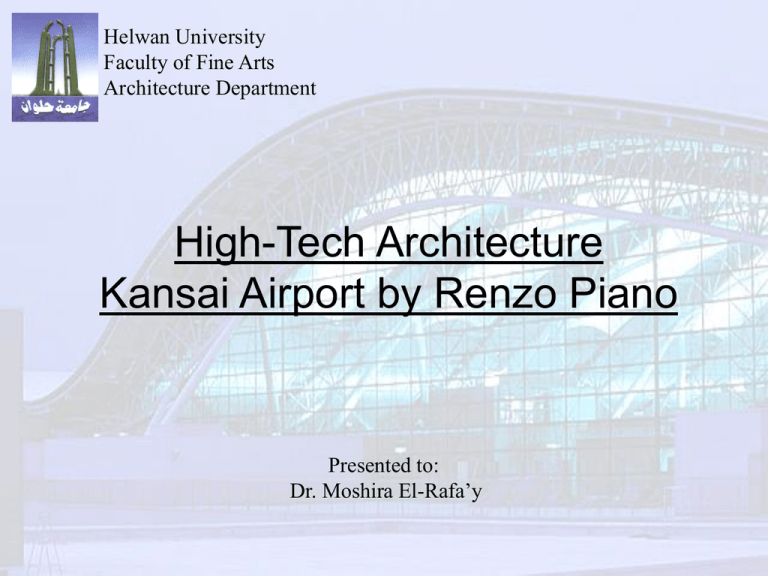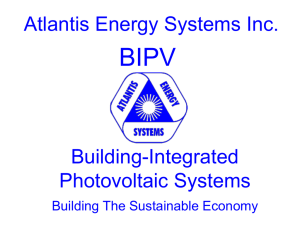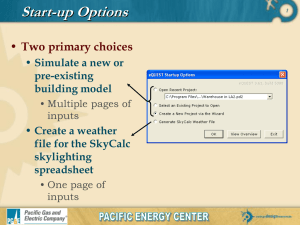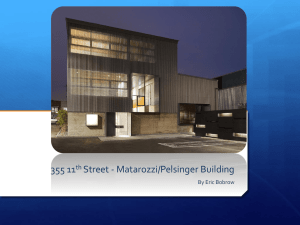High-Tech Architecture
advertisement

Helwan University Faculty of Fine Arts Architecture Department High-Tech Architecture Kansai Airport by Renzo Piano Presented to: Dr. Moshira El-Rafa’y High-Tech Architecture: There are three anomalies to High-Tech architecture which will amuse anyone with a taste of iron. The High-Tech architecture is highly annoying to the public, because the style looks functional but exposing the structure and surfaces is expensive at the outset and exception for the ease of replacement and cleaning and maintaining in a pristine shape. However the High-Tech architecture is not presented as a religious or even stylistic mood. Rather it is justified for its supposed functional virtues and presented as a necessity. The services and structure of a building are almost always exposed on the exterior as aform of ornament or sculpture A prime example is Roger’s Inmost factory, which makes an extraordinary feature of it’s H-section, top tension members, and ducts which jump above two sheds. The long horizontal spans are used for the production of silicon chips and thus require the cleanliness and openness of a giant surgery. As for the principle in general, critics content that exposing surfaces and structure is expensive.. Examples on High-tech Projects: 1-Millenium Dome, by Sir Richard Rogers, London, England. An exposition hall constructed of fabric enclosure and tensile support built on 1999. 2- Tokyo International Forum, by Rafael Vinoly, Tokyo, Japan. An exhibition hall and conference center constructed of steel frame, megatruss and Glass curtain walls built on 1996. 3-Stansted Airport, by Sir Norman Foster, London, England. An airport constructed by steel frames, built on 1991. 4-Centre Pompidou, by Renzo Piano, Paris, France. A Modern art museum constructed by high-tech steel and glass, built on 1976. 5- Hong Kong and Shanghai Bank, by Sir Norman Foster, Hong Kong. A Skyscraper commercial and office tower and bank headquarters, constructed by steel frame and glass, built on 1986. Kansai Airport Kansai Airport, by Renzo Piano, Japan. The world's first international airport on the sea. "Kansai International Airport" was built on a man-made island on the sea, about five kilometers off the coast of Senshu in Osaka Bay. It opened on September 4, 1994. The huge, long building stretching 1.7 kilometers alongside the 3,500-meter runway is the passenger terminal building. The new airport was planned with the theme of harmony with nature, to achieve "a man-made island airport five kilometers out to sea." Construction took seven and a half years from the start of land reclamation work to the airport's opening. Currently there is only one runway, but as the new gateway to Japan's skies, there are grand plans to ultimately extend it to three runways, transforming it into an international hub airport . Design Concept The airport's construction site is situated 5 kilometers off Sanchu district in about 18 meters of water and where the seabed is extremely soft. The man made island is about 5 kilometers square and surrounded by a seawall with average high 23 meters. As the whole structure had to fit on a man made island, space consideration was an important factor when designing the kansai airport it had to be able to fit parking structure and the run way ,as well as the facilities required for high tech airport. The chosen shape was that of a torroid, and is pretty obvious when observing the structure from outside. The torriod, a spherical shape like that of a bicycle tire, would allow the center of the terminal to be as high as 85 feet, and yet taper to twenty feet at the wings. A sketch for the airport's idea by RENZO PIANO This innovative design allows the second floor to house forty-one gates at a distance of one mile, making this terminal the longest building in the world. The continuously curving and tapering aerofoil shape as projected from the outside completes this architectural masterpiece This settlement was counteracted by the use of hydraulic jacks, diaphragm walls, and the seawall built around the island. On one side there was a road and on the other side a field where air craft landed into the wind. ENTRANCE: Another distinctive design element is the four-story-high "canyon" which greets visitors as they enter the main terminal building from a connecting concourse. THE ATRIUM: The atrium is the center of this structure, and gives the structure the resemblance of a bird from the out side with giant wings out stretched on both sides. all four floors of the terminal can be seen from this point . structure of the atrium: The most amazing aspect of this design is that there is no objects to obstruct the view of the passengers in any direction. This innovative design allows the second floor to house forty-one gates at a distance of one mile , making this terminal the longest building in the world. One problem that ended up with an innovative solution was an issue that the mechanical engineers were faced with when designing a system to air condition such a large, unobstructed space. A stream of air flowing across the airfoil shape of the outer shell would transfer the flow twice as far as would a flat surface . One of the terminal's interesting design features is its roof support system , which consists of consecutively placed, large-span tubular steel trusses whose curved contours suggest the edge of a Japanese – style sword. The configuration of the individual trusses crafted from a single continuous piece of steel is alerted slightly to achieve the gentle downword roof slope of the terminal wings. Structural Elements AIRSIDE GLAZING : consists of repeated uniform identical sized panels. A lot of the structure is glass, including infrared absorbant glass used to give a contrast with the roof materials. This reduces the heat burden and gives a higher sense of a floating roof. ENDWALL GLAZING : This is also composed of infrared absorbent tempered glass. An important factor to consider was how to create the facade and its light materials. Steel was the major element used in construction. All the members of the bow truss were painted with a special paint to avoid rust formation, and the roof appears to sail upwards. FIRE CLADING : From the earlier planning stages, the design has been proceeded to make clear distinction between the portions with fireproof coating and those without . TRUSSES: The inverted triangle shaped trusses are referred to as the 'A' truss type, and this constitutes the 18 trusses of the structure. Each of these is supported by inclining colums, and on the curbside, by vertical columns. The height gradually decreases towards the airside, giving it the wing-shell structure . METAL PANELS: Small variations of angles are absorbed at the joints, allowing the entire roof to be covered with a single type of panel DULL FINISH: In order to make sure that the roof disperses light rather than reflect it when viewed from the control tower or cockpit of a plane, a dull finish was preferred LIGHTING : During the daytime, there is a dynamic combination of artificial and natural light, with soft airy light from the open air ducts and sharp and clear light flowing in from above the trusses. SOUND : Soundproof rock-wool boards cover the ceiling roof, and this material placed between the 2 upper chords of the trusses is raised to a point at which the secondary structure can be seen. On the other hand, between trusses, the celing is hung so that the finished ceiling surface meets the center line of the upper chords . THE ROOF: The roof descends towards the roof end and down pipes are attached every 2 spans on the inside of the glass. The glass surface is simply attached on the front of the mullions. The Wing ribs pass through the glass, and are connected to outside columns by pins STAINLESS STEEL PANELS : The roof in traditional Japanese architecture constitutes an extremely large part of the whole building. Metal panels were placed over the steel deck to enhance the design effect of a single roof covering the entire structure. BENT SHEETS OF STEEL DECK: It provides insulation and drainage. A layer of air passes between the bent sheet and the stainless steel panels, reducing the burden of high temperatures. DULL FINISH : The roof must disperse rather than reflecting light when viewed from the control tower or cockpit of a plane. METAL PANELS : Choices of materials were constrained by consideration of the fact that the building was being constructed on a landfill island surrounded by sea. Metal panels were placed over the steel deck to enhance the design effect of a single roof covering the entire structure . Architectural drawings Plan of the airport Section of the roof Birds view perspective of the roof Main terminal building truss perspective view Research presented by: -Dalia Essam El-Din Aly -Radwa Magdy Hussein -Sara Amir Mohamed -Amr Adel Mohamed -Fatma Ibrahim El-Kassas -Mohamed Ahmed Mahmoud Eid -Mohamed Raouf Saber -Mahmoud Gamal Mohamed -Marwa Said El-Maghraby -Nermin Aly Waly -Hager Mohamed Abd El-Aziz -Hend El-Said Hussein (28) (37) (45) (61) (63) (79) (81) (84) (87) (95) (103) (107)









